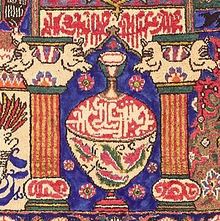Kashmar Rug
| Kashmar Rug | |
|---|---|
 Design of Kashmar Rug (Rugman) | |
| General information | |
| Name | Kashmar Rug |
| Original name | فرش کاشمر، قالی کاشمر |
| Alternative name(s) | Kashmar Carpet |
| Origin | |
| Category | City |
| Technical information | |
| Common designs | Afshan, Shahabbasi |
| Common colors | Crimson, Ivory, Blue, Green |
| Dyeing method | Natural, Synthetic |
| Pile material | Wool |
| Foundation material | Cotton |
| Knot type | Asymmetrical (Persian), Symmetrical (Turkish) |
Kashmar rugs originate from Kashan, located in the Province of Khorassan, just southwest of Mashad. It is reputed to produce some of the highest quality area rugs in eastern Iran in addition to being a collection point for Baluch tribal area rugs. The weaving of Kashmar rugs can be traced back to the 1500s. They are quite rare and historically very important. Much the same as books, Kashmar rugs tell the stories of the rich cultural life and history in the region. Kashmar is the home to many master weavers who use Persian knots to create their fine works of art.
History
Kashmar is a city located in the Khorasan Province of eastern Iran. It is a trade center for towns, villages, and tribes of the surrounding area. The market is active, selling secondary-grade Khorasan carpets from the region and Baluch rugs from the neighboring villages and tribes. The well-known Azghand carpets from the nearby town were traded in Kashmar from the late nineteenth century up until World War II. Dealers from Meshad are active in the Kashmar market and usually send their purchases to the Meshad bazaar for better marketability. Kashmar and Baluch rugs[1]
are known in the market from the late nineteenth century.[2]
Kashmar carpets woven in the city or in the surrounding towns are called "Kashmar Khorasan." The carpets have a cotton foundation and a wool pile, with the Persian (asymmetric) knot. The designs are traditionally floral, with a medallion with corner medallion quadrants or allover styles. Some designs have an open field with a large center medallion. The backgrounds are mainly pomegranatered (from cochineal), with dark blues, light blues, ivory, and different shades of green, gold, and brown used for the design elements and border field. Kashmar sizes are made from five feet by three feet to large room dimensions.
The Baluch rugs woven in the region are called "Kashmar Baluch." Older rugs have a wool foundation and a wool pile, but after World War II most of the weavers switched to a cotton foundation with a wool pile and a lower-grade weave quality. The Persian (asymmetric) knot is applied.
Kashmar Baluch rugs have allover, Mihrab (prayer arch), and, at times, large center-motif designs. The colors for the field are reds, dark blue, and occasionally ivory or camel. Shades of brown, cinnamon, and blue are used for the design elements. Dark brown or black is used for design outlines. Baluch formats vary from small bags to Prayer rugs in sizes ranging from approximately four feet by two feet six inches to seven feet by four feet.
By the late twentieth century many weavers from Kashmar had transitioned away from customary designs to patterns similar to other weaving regions in Iran following the demand of domestic and foreign consumers.[3]
See also
| Search for Kashmar Rug on Wikipedia. |
References
Bibliography
- Abraham Levi Moheban. 2015. The Encyclopedia of Antique Carpets: Twenty-Five Centuries of Weaving. NewYork: Princeton Architectural Press.